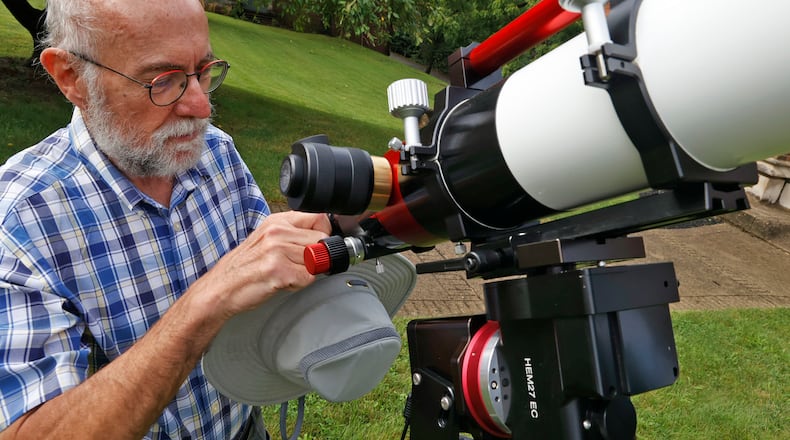“I had absolutely no idea this was in the works,” Fleisch said.
He said the good news about 17037 Danfleisch is, “unless it suffers a close encounter with another object that significantly changes its orbit, it will never get closer to Earth than 106 million miles, so no danger of crashing into us.”
It was discovered on March 16, 1999, and is located in the asteroid belt between Mars and Jupiter.
“Anyone visiting would find that their weight is less than one pound, and they could easily throw a baseball from the surface into orbit, even wearing a space suit — since there’s no atmosphere, so no air to breathe,” Fleisch said.
Fleisch is recognized as an American astronomer who at Wittenberg University specialized in electromagnetics and space physics. He authored six Student’s Guides books with Cambridge University Press, was Ohio’s Professor of the Year in 2010 and in 2013 was named one of the top 25 Science, Technology, Engineering, and Mathematics (STEM) professors in Ohio.
He has been known for presentations to local youth groups and for going the extra mile for his students. In 2008, he went the extra 700 miles, flying at Christmas to Canada to deliver a copy of one of his books to a student whose relative had said the copy he purchased had printing issues. The story went viral, gaining attention from the News-Sun and then national and international media.
Fleisch earned his bachelor’s in physics from Georgetown University and his master’s in space physics and astronomy from Rice University. He joined the Wittenberg faculty in 1998.
He received the word on the minor planet naming honor from Kat Volk of the Planetary Science Institute and Julia Kregenow of Penn State, both of whom are graduates of the Wittenberg Physics Department.
“I had served as the Grand Canyon Astronomer in Residence in the fall of 2022, and when I was invited back in August, I asked both Dr. Volk and Dr. Kregenow to help out with the presentations and observing sessions conducted under the clear skies of the South Rim,” Fleisch said.
Kregenow wrote a letter of support for the 2010 Professor of the Year award.
“When I see him bending over backwards for his university and his community — not just working day and night for his students, but also committing hundreds of hours per year to volunteer public outreach events bringing science and astronomy to the public — it is evident that Dan truly wants to be there,” she wrote then.
Kregenow and Fleisch wrote a textbook together in 2013 and said her respect and esteem for Fleisch has continued to grow through the years.
“Dan wants to share the universe with the world. He has always been like that,” she said.
Kregenow said people gravitate to him.
“He treats every question as valuable and makes time for everyone,” she said. “Audiences hang on his words, emitting regular ooh’s and aaah’s.”
Fleisch’s presentations use approachable everyday language combined with enticing technical jargon, plus stunning images.
“And despite being one of the most accomplished, celebrated and universally loved (pun intended) teachers I’ve ever met, he maintains an understated humility, grace, and warmth that draws people in,” Kregenow said.
Fleisch is working with the Springfield Symphony Orchestra this week to present “The Planets.”
17037 Danfleisch is 2.4 miles in diameter. It is 200 to 221 million miles from the sun and takes 3.4 years to complete one orbit of the sun.
The honor came from the Working Group Small Bodies Nomenclature and in the NASA/CalTech Jet Propulsion Lab (JPL) Small-Body Database.
The International Astronomical Union lists as series of rules for naming minor planets, a process that can take decades.
Names must be 16 characters or less in length and preferably one word.
The rules also include this note: “It is not possible to buy a name for a minor planet. If you have a name you would like to apply to a minor planet, the best advice is go out and discover one!”
About the Author

